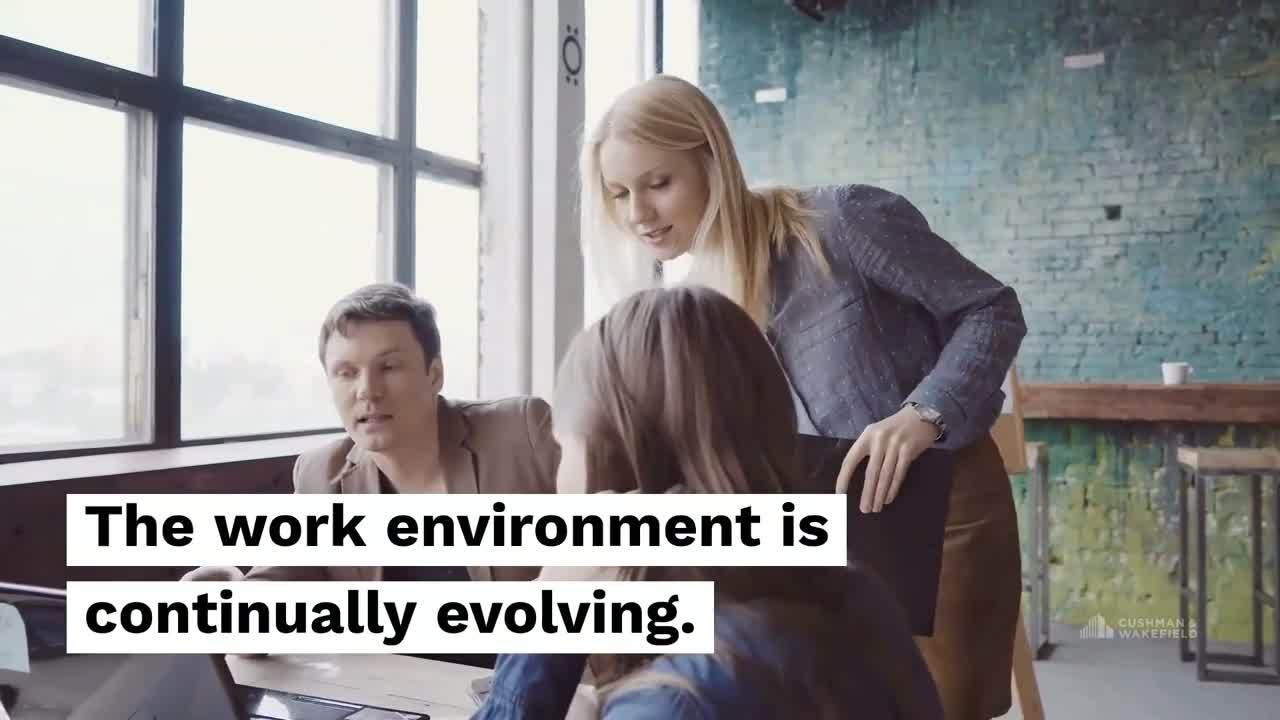
The work environment is continually evolving in order to attractand inspire people to do great work, so that businesses can grow and flourish. But with so much ongoing change, how do you keep up with and navigate the impact of new trends and, armed with this knowledge, future proof your workplace?
It’s Not just an Office. It’s an Ecosystem.
The average person spends one-third of their life at work. That’s more time than they spend on any other single activity, including family events, vacation and even sleep. In this context, it’s easy to consider that the interaction with the workplace is the single most dominant factor in employees’ lives. Considering this, the impact that the workplace has on employee experience, productivity, wellness, innovation, collaboration and talent retention is undeniable.

Businesses spend up to 90 percent of their budgets on people costs, almost all of which remain outside of the scope of commercial real estate (CRE) providers who are generally tasked to address limited elements, specifically energy costs (one percent) and rent costs (nine percent).
More than three-quarters of global CEOs see accessing and retaining skilled labor as the biggest threat to their businesses. The war for talent is often won by creating an optimal workplace that embodies the corporate brand, culture and values; supports the wellbeing & engagement of employees; builds community; and inspires people to do their best work. The company that can harness a truly differentiated approach to the workplace – with tangible and measurable benefits – will enjoy an unmatched competitive advantage in the marketplace.
Technology and flexibility continue to impact the workplace. Work is no longer somewhere employees go to, but something they can do from anywhere. Companies that evolve their perception of the workplace from a single location or building to a network of physical and virtual places will empower their people and their business to thrive. It’s clear that workplace transformation is more than just a trend, but there is confusion around what workplace means, as a word and as a CRE service.
For some providers, workplace services are limited to the design and construction of the physical space. For others, it’s an a la carte menu of experience-oriented services or simply coworking and flex-working options. Workplace includes all of this, but it also extends to much more.
Focus on Space Efficiency and Agility
Millions of square feet of office building space is currently underutilized, many building management tasks are completed reactively and energy costs are largely opaque and expensive. However, this can be avoided by leveraging sensor technology, allowing occupiers and owners to gain actionable insights into space utilization, preventative maintenance and energy use/ costs. Estimates predict smart buildings could save $20-$25 billion* in annual energy costs (see article on page 41, “Smart buildings and the employee experience”).
It’s important for companies to diversify workplace portfolios to a mix of fixed, flexible and on-demand spaces to support business agility. The growth in the flexible-space market, including coworking, has been nothing short of remarkable.
Coworking has evolved from a trend to mainstream, with many service providers offering a variety of space options from the individual entrepreneur to enterprise solutions for blue-chip corporates. The provision of third spaces by institutional landlords within prime-grade offices is increasingly common as is the development of their own coworking brands. As the lines between the facilities and services offered by fixed, flexible and on-demand spaces become increasingly blurred, it gives occupiers greater scope to actively manage their portfolio for optimum efficiency and productivity.
Focus on People, Experience & Wellbeing
People are companies’ most important asset yet as an industry, we have not actively managed the impact our workplaces have on our people.
- IN THE U.S., THE COST OF WORK-RELATED STRESS IS ESTIMATED AT $1.1 TRILLION
- IN EMEA, CHRONIC DISEASES COST EMPLOYERS $650 BILLION EVERY YEAR
- 47% OF EMPLOYEES FEEL THAT THEIR WORKSPACE DOES NOT SUPPORT PRODUCTIVITY
- 70% OF EMPLOYEES DO NOT FEEL ENGAGED IN THEIR JOBS
The current state presents us with a fundamental opportunity for improvement. Companies with engaged employees enjoy two times typical revenue growth. The potential for value-driven transformation through employee productivity and experience is compelling.
One-third of employees’ sick leave can be attributed to poor indoor air quality. Improved environmental conditions – air quality, light and noise – can positively impact worker productivity between .5 percent and 5 percent, translating between $20 and $200 billion in revenue in the U.S. alone.
Focus on the Planet
More than 90 percent of the world’s 250 largest companies engage in sustainability reporting. From that, 40percent of global carbon emissions come from office building and 70 percent of all electricity consumption (in the U.S.) goes to support building operations. Smart buildings have the potential to reduce U.S. carbon emissions by 130-190 million tons of CO2. The future of CRE is delivering solutions that are smart, green and well. Corporates must deliver top-line performance that benefits their people, their communities and our planet. (see article, “Healthy working: wellness and sustainability in the workplace”).
Why Now?
Business is evolving. The Business Roundtable, an association of nearly 200 American CEOs from companies such as JP Morgan Chase, IBM and General Motors, issued a pledge to deliver long-term value to all stakeholders. This new proposed model is positioned as the greatest platform for social change and includes:
- Delivering value to customers
- Investing in employees
- Dealing fairly and ethically with suppliers
- Supporting communities
- Generating long-term value
The paradigm shift rejects the short-sighted push to produce quarterly profits at the expense of employees, clients and the community. The old way of doing things isn’t going to work anymore, and both occupiers and investors need to make this pivot to drive long-term value, improve the employee experience, minimize negative environmental impact and create thriving ecosystems.






